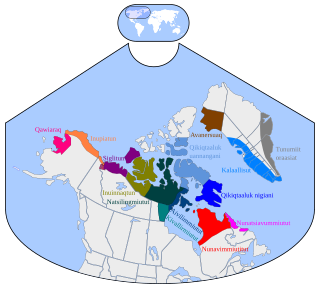
Back Inuktitut Afrikaans Idioma inuktitut AN اللغة الإنكتيتوتية Arabic Llingües inuit AST İnuktitut Azerbaijani اینوکتیتوت AZB Інукцітут Byelorussian Инуктитут Bulgarian Inuktitut Breton Inuktitut Catalan
| Inuktitut | |
|---|---|
| Eastern Canadian Inuktitut | |
| ᐃᓄᒃᑎᑐᑦ, inuktitut | |
| Native to | Canada |
| Region | Northwest Territories, NunatuKavut, Nunatsiavut (Newfoundland and Labrador), Nunavik (Quebec), Nunavut |
| Speakers | L1: 38,000 (2021 census)[1] L1 + L2: 42,000 (2021 census)[2] |
Early forms | |
| Dialects |
|
| Inuktitut syllabics, Inuktitut Braille, Latin | |
| Official status | |
Official language in | Nunavut Northwest Territories |
Recognised minority language in | |
| Regulated by | Inuit Tapiriit Kanatami and various other local institutions. |
| Language codes | |
| ISO 639-1 | iu Inuktitut |
| ISO 639-2 | iku Inuktitut |
| ISO 639-3 | iku – inclusive code InuktitutIndividual codes: ike – Eastern Canadian Inuktitutikt – Inuinnaqtun |
| Glottolog | east2534 Eastern Canadian Inuktitut |
| ELP | Inuktitut |
| Linguasphere | 60-ABB |
 Distribution of Inuit languages across the Arctic. East Inuktitut dialects are those coloured dark blue (on the south of Baffin Island), red, pink, and brown. | |
| Person | Inuk, ᐃᓄᒃ Dual: Inuuk, ᐃᓅᒃ |
|---|---|
| People | Inuit, ᐃᓄᐃᑦ |
| Language | Inuit languages |
| Country | Inuit Nunangat, ᐃᓄᐃᑦ ᓄᓇᖓᑦ |
Inuktitut (/ɪˈnʊktətʊt/ ih-NUUK-tə-tuut;[3] Inuktitut: [inuktiˈtut], syllabics ᐃᓄᒃᑎᑐᑦ; from inuk, 'person' + -titut, 'like', 'in the manner of'), also known as Eastern Canadian Inuktitut, is one of the principal Inuit languages of Canada. It is spoken in all areas north of the North American tree line, including parts of the provinces of Newfoundland and Labrador, Quebec, to some extent in northeastern Manitoba as well as the Northwest Territories and Nunavut. It is one of the aboriginal languages written with Canadian Aboriginal syllabics.[4]
It is recognized as an official language in Nunavut alongside Inuinnaqtun and both languages are known collectively as Inuktut. Further, it is recognized as one of eight official native tongues in the Northwest Territories.[5] It also has legal recognition in Nunavik—a part of Quebec—thanks in part to the James Bay and Northern Quebec Agreement, and is recognized in the Charter of the French Language as the official language of instruction for Inuit school districts there. It also has some recognition in NunatuKavut and Nunatsiavut—the Inuit area in Labrador—following the ratification of its agreement with the government of Canada and the province of Newfoundland and Labrador. The 2016 Canadian census reports that 70,540 individuals identify themselves as Inuit, of whom 37,570 self-reported Inuktitut as their mother tongue.[1][6]
The term Inuktitut is also the name of a macrolanguage and, in that context, also includes Inuvialuktun, and thus nearly all Inuit dialects of Canada.[7] However, Statistics Canada lists all Inuit languages in the Canadian census as Inuktut.[6]
- ^ a b "Mother tongue by geography, 2021 Census". Statistics Canada. 17 August 2022.
- ^ "Knowledge of languages by age and gender: Canada, provinces and territories, census divisions and census subdivisions". Statistics Canada. 17 August 2022.
- ^ "Inuktitut". Merriam-Webster.com Dictionary. Merriam-Webster.
- ^ "field to show translation -> 10 facts about Canadian Aboriginal Languages". Wintranslation.com. 12 February 2014. Archived from the original on 12 September 2019. Retrieved 15 July 2015.
- ^ Cite error: The named reference
:2was invoked but never defined (see the help page). - ^ a b "Census Profile, 2021 Census of Population, Comprehensive download files, Canada, provinces and territories" (CSV). Statistics Canada. 5 August 2022. Retrieved 7 January 2023.
- ^ "Inuktitut | Ethnologue Free". Ethnologue (Free All). Retrieved 30 August 2023.